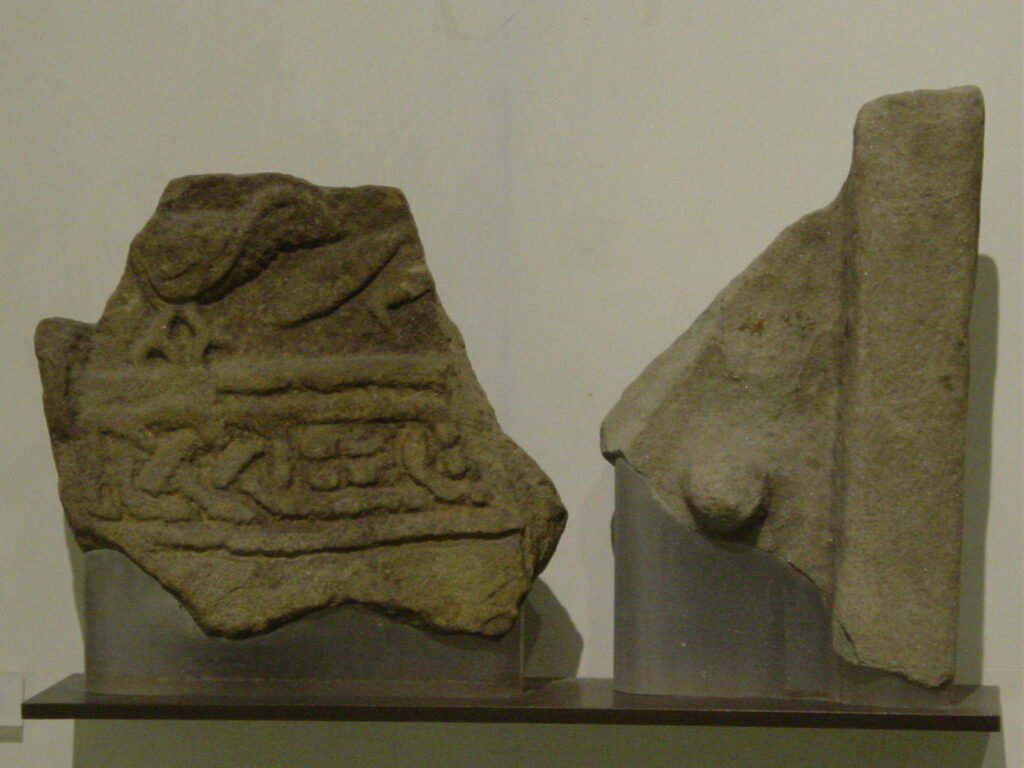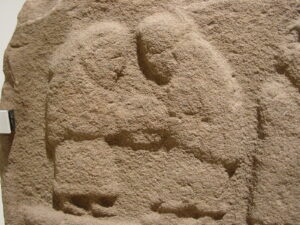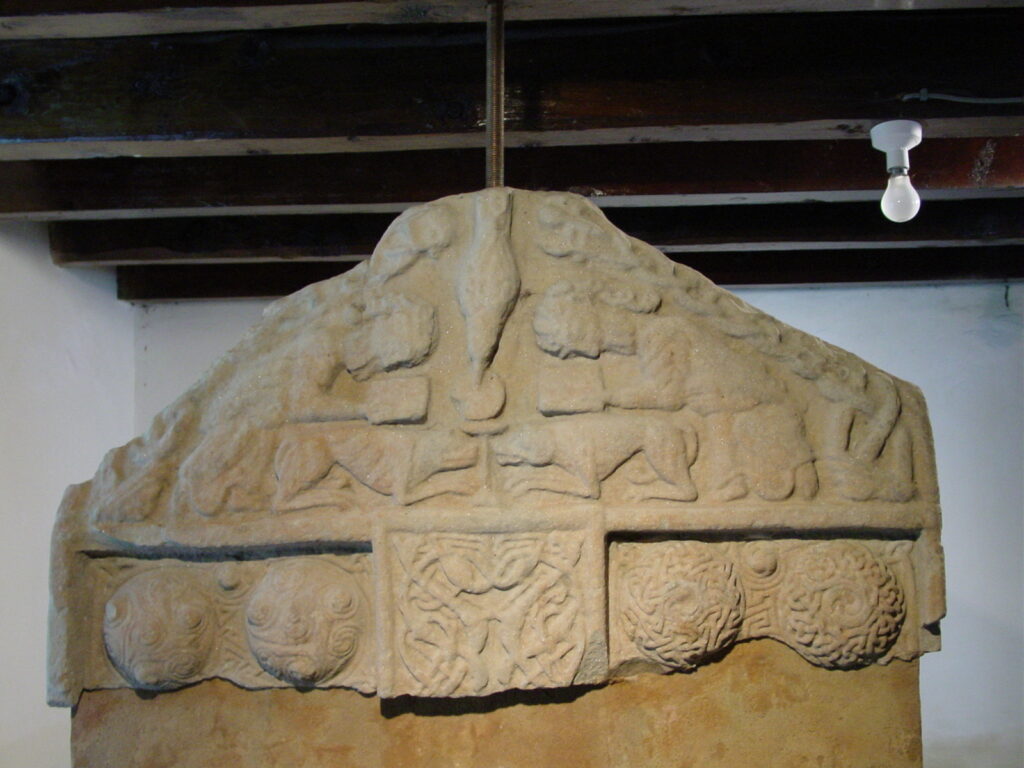Welcome to the Kitchens! This is the repository for all my food-related research. Food production and preparation is an area I am just getting into, so this is likely to be a bit more sparse than other pages on this website, but I am finding it an enjoyable endeavor, so come play with me in the kitchen!
The Bread Oven
One of my first projects was to make a historically plausible Pictish Bread. I started with a basic bread recipe and then made substitutions as appropriate until I had produced a bread that included only ingredients that could have been used in Pictish Scotland. The first substitution was stone ground whole wheat for normal bread flour, but soon I replaced that with stone ground whole wheat spelt, as spelt was the type of wheat most likely to have been used in Pictish Britain. Luckily, spelt is becoming popular in health food stores as a low-gluten wheat and so it is not terribly difficult to find. The next substitution was for a whole-wheat specific yeast. The Picts probably used a wild yeast or a starter, but since I bake only intermittently, I settled for a yeast that is commercially available but well suited to whole wheat breads. However, even with the special yeast, the bread was not satisfactory. It was not very springy and it did not rise nicely because of the low gluten content. I chose to add some eggs to improve its elasticity and that seemed to do the trick. While I cannot prove that the Picts used eggs in their bread, I can prove that they kept chickens. There is a Pictish carved stone fragment that includes a picture of a chicken! (See photo below) I used this as justification for my egg use. Lastly, I have recently been experimenting with various oils, including flax seed, rape seed, and thistle oils. It is also very possible that this Picts used an animal fat instead of an oil, but I prefer to use vegetable oils. My current recipe for Pictish bread



Beyond the Well
Sekanjabin
Sekanjabin has long been one of my favorite drinks. It is essentially a vinegar simple syrup that can be stored unrefrigerated and then diluted to taste when a refreshing beverage is desired. It is often referred to as “medieval Gatorade” because of its hydrating properties. The most simple recipe is to dissolve four cups of sugar in two and a half cups of water over medium heat. Then add one cup of vinegar and simmer for 30 minutes to reduce the volume. Then mint leaves are added and the syrup allowed to cool. When cool, the mint leaves are removed and the syrup can be bottled for later use. The key to making a successful sekanjabin is to use a quality vinegar. If you like strong vinegar flavors, consider a balsamic vinegar, if you are not a fan of a vinegar flavor, use a good quality apple cider vinegar. (Never, never use a cheap white vinegar!) Mint is optional and can also be replaced with other flavorings, as your taste dictates. I particularly like to replace some of the water with a fruit juice – pomegranate, for instance. However, have a care that your chosen vinegar and chosen are an appealing combination. Balsamic works well with spices, apple cider works best with fruits. Experiment and have fun with it, the classic recipe is just the beginning! My printable sekanjabin recipe can be found here.
Other Beverages
While not medieval that I know of, Rose’s Lime mixed with cold water or seltzer is one of my favorite summer coolers. Other syrups, like the blackcurrant or lingonberry syrups from IKEA are also divine, if lacking in evidence or documentation. At least they look a whole lot better than a Coke! Beer and soda are generally good medieval beverages too, if the site allows, but are not my specialty.
Resources and Research
Gode Cookery
For those of you just beginning to play with period cookery, there are few sites I can recommend more highly than Gode Cookery. They provide a fine selection of recipes – from modern with a period flavor to pre-redacted period recipes along with fine commentary about period cooking and a lovely database of images related to period food and feasting. It is a great place to explore and try things out before delving into redaction on your own.
Cariadoc’s Miscelleny
The Miscelleny contains any number of excellent things, but one of its notable sections is its food and cooking information. An excellent source for beginning to intermediate cooks.
Atlantean MOAS on Food and Drink
As always, the Atlantean MOAS site compiles a fine selection of links about any given topic. While there is a wealth of knowledge on these links, use some little discretion, as the links are of variable quality and often some are defunct or otherwise out of date.
Materials and Suppliers
The materials you will need for your medieval cooking endeavors will vary widely depending on your chosen dishes and how many people you aim to feed. Below are just some of the sources I have used for my cooking projects. You may find these helpful or not, depending on your own projects’ requirements.
Foodstuffs
Spelt – An ancient form of wheat. Spelt can often be found in health food stores or stores that cater to people avoiding gluten and is often available in a coarse stone-ground variety. With its increasing popularity and several brands now on the general market, it should not be terribly hard to find in major cities or can be ordered online. Whole Foods carries several brands of spelt and even has some in their bulk foods section sometimes.
Emmer – Another type of ancient wheat, but somewhat more difficult to find. Emmer may need to be special ordered online.
Oils – Most oils you will need for medieval cooking can be had at the local grocery store. Some odd oils, like flaxseed oil, can be found in ethnic food stores, natural food stores or natural medicine stores. However, if you are looking for something really unusual, you may need to have it special ordered or visit Vom Fass, if you are lucky enough to have one nearby.
Vinegars – most grocery stores carry at least a few different types of vinegar. Experiment to see which taste best to you and don’t forget to try the flavored ones. For more exotic flavors, try Vom Fass. It’s an unusual shop, but where else are you going to get sloe vinegar?
Cookware, Utensils, and Serving
Ironware – One of my favorite cooking items is a spiral Viking pan from Danr at Iron Tree Works and I’m currently lusting after a lipped pan and a tripod set… I highly recommend his wares for both their quality workmanship and their beauty.
Pottery – My favorite potter is Eadric the Potter, who has now cruelly moved far away from the Midwest but can often be seen at Pennsic War. I need to do some more research about specifically Pictish pots before commissioning some pieces, but he does a wonderful range of periods, with particular attention to documenting shapes, colors, clays and glazes (or noting departures from the “right” ones). Again, highly recommended.
